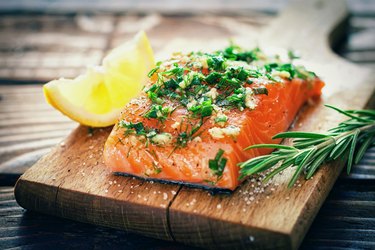
Unless you follow a vegetarian or vegan diet, you likely meet most of your daily protein needs by eating meat, poultry and seafood. But do you know how much you really need?
Along with fat and carbohydrates, protein is a macronutrient that we all need to consume each day. Animal proteins like meat and seafood are considered complete proteins, which means they deliver all nine of the essential amino acids your body needs to stay healthy, per the Harvard School of Public Health.
According to the United States Department of Agriculture (USDA), adults who get less than 30 minutes per day of moderate physical activity should aim for the following amounts of protein daily, depending on age and gender:
- Women ages 19-30: 5 1/2 ounce equivalents
- Women ages 31 and older: 5 ounce equivalents
- Men ages 19-30: 6 1/2 ounce equivalents
- Men ages 31-50: 6 ounce equivalents
- Men ages 51 and older: 5 1/2 ounce equivalents
So, what's an "ounce equivalent?" In general, it's equal to an ounce of meat, poultry or seafood. When it comes to veggie sources of protein, though, the measure refers to a quarter cup of cooked beans, a half ounce of nuts or seeds and a tablespoon of peanut butter.
OK, so you know how much you should be getting. But short of weighing every item that goes on your plate, how can you determine just how much you're actually getting? Enter our guide, which makes it easier by comparing USDA-recommended protein serving sizes to everyday objects.
Read more: 5 Tips for Eating Protein the Right Way
White Meat

Serving: 3 ounces
About the size of... a deck of cards
Calories: 170 (chicken breast); 160 (turkey breast)
Poultry, like chicken and turkey, is full of protein — typically around 20 to 25 grams per serving, according to the USDA — and is generally considered a lean meat, meaning it provides relatively few calories from fat.
Chicken breast is one of the leanest cuts of meat, with only about 60 total calories coming from fat. The darker cuts of the bird, including the thighs and drumsticks, are slightly higher in calories and fat, but they also deliver more of the minerals iron and zinc, which help support your immune system.
A serving of turkey breast contains about 70 calories from fat and is high in the amino acid tryptophan, which your body uses to make melatonin and serotonin, the hormones that make you sleepy and promote good sleep, according to the U.S. National Library of Medicine.
Red Meat

Serving: 3 to 4 ounces
About the size of... a regular iPhone
Calories: Varies by cut
Beef, lamb and pork are all considered red meat, according to the World Health Organization.
The most common cuts of beef come in the form of steak and ground beef or hamburger. While the calorie count for steak can vary depending on the cut and fat, a 3 1/2-ounce serving is about 310 calories, according to the USDA. On the other hand, a 4-ounce serving of hamburger is about 240 calories.
In comparison to beef, lamb is a lower calorie alternative to steak but still offers a flavorful alternative to poultry. A 3-ounce serving of lamb is about 250 calories with 152 calories from fat, according to the USDA. Lamb is high in vitamin B12, which is crucial for red blood cell formation and proper nerve function, according to the Mayo Clinic.
Pork loin is the lowest-calorie red meat option per 3-ounce serving with 206 calories per serving, according to the USDA, and only 88 calories from fat. Pork is also high in thiamine, a B vitamin that supports healthy metabolism as well as nerve and muscle function, according to the National Institutes of Health (NIH).
While red meat offers a host of nutritional benefits, it has also been linked to colon cancer, according to the American Institute for Cancer Research, which recommends limiting your intake to no more than three portions per week.
Fish

Serving: 3 to 4 ounces
About the size of... a checkbook
Calories: 121 (salmon); 114 (tilapia); 124 (tuna)
Salmon is one of the most popular fish options and has become a staple protein at most restaurants. This fish is probably best known for being high in omega-3 fatty acids (fish oil), which may help reduce the risk of heart disease, per the USDA.
Tilapia is among the most nutrient-dense proteins, according to the USDA. It's an especially good source of potassium, a mineral that helps keep your heartbeat regular and can help offset some of sodium's harmful effects on blood pressure, according to MedlinePlus.
At 28 grams per serving, tuna is high in protein and also rich in magnesium, which is necessary to ensure proper muscle and nerve function, according to the NIH.
Overall, fish and other seafood are low-fat sources of protein packed with healthy nutrients — but unfortunately, most of us aren't getting the amount recommended by the 2015-2020 Dietary Guidelines for Americans, which are compiled by the USDA and U.S. Department of Health and Human Services. Per week, adults should be eating 8 to 10 ounces of seafood, but most people are only getting between 1 and 5 ounces.
Seafood
Serving: 3 ounces
- 8 to 9 medium shrimp
- 9 to 12 medium scallops
- 8 to 9 pieces of calamari
About the size of... a tennis ball
Calories: 100 (shrimp); 90 (scallops); 149 (calamari)
Shrimp, like most seafood, is relatively low in calories, according to the USDA. Plus, a serving of shrimp provides nearly the daily recommended value of selenium, a nutrient that promotes reproductive health, according to the NIH. Shrimp are also high in astaxanthin, an antioxidant found in algae (which shrimp eat) that helps protect against inflammation and may help prevent neurodegenerative disease, according to a February 2017 review published in Geroscience.
Scallops are high in zinc, which helps promote your immune system, according to the Mayo Clinic. A 3-ounce serving supplies you with about 17 grams of protein, according to the USDA.
Finally, one of the most popular seafood options: calamari. Also known as squid, this is a common appetizer on most menus, but it's often served battered and fried, making it high in cholesterol and sodium, according to Harvard Health. For a healthier option, opt for grilled calamari, which is still high in zinc and vitamin B12.